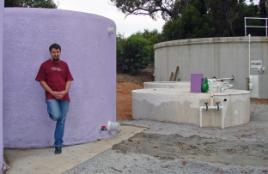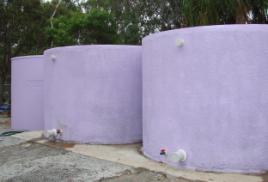Qld inventor key to eco-development's success
Published on 20 September, 2007

Ben Kele is the project manager and innovator behind the wastewater treatment system installed at Sunrise.Rockhampton water expert Ben Kele's wastewater treatment system is the cornerstone of a coastal community development which derives all its water from on-site sources and recycles its own waste.
Awarded for Excellence in Environmentally Sustainable Development from the Urban Development Institute of Australia (Qld), Sunrise at 1770 is a $22 million coastal development 10km from the Town of 1770, a beach township in Central Queensland.
Sunrise is self-sufficient when it comes to water, with no mains connected and no off-site discharge. It draws water from 3 sources - rainwater tanks, a bore replenished from the Reedy Creek Aquifer and Kele's on-site wastewater treatment system.
Kele, a researcher from Central Queensland University's Plant Sciences group, is the project manager and the innovator behind the wastewater treatment system installed at Sunrise.
Recycled water is stored in 3 central 150kL tanks and used in toilets and outdoors - when legislation eventually catches up with technology there are plans to hook up the washing machines and even drinking taps.
The wastewater treatment system can treat up to 300kL a day. With each home having a dual septic system connected to a holding tank, effluent is pumped to a 220kL concrete tank and then to 2 anoxic tanks where the removal of nitrogen starts to take place as well as some phosphorous.
The next stage is 2 large filter tanks filled with volcanic rock (zeolite and scoria). Nasties such as potassium, ammonium and sodium are stripped out, decreasing the acidity and nitrogen risk. A few good minerals are put back in by a chemical exchange, including magnesium and calcium.
A high velocity sonic disintegrator developed by Australian company Water Fresh, uses sound waves to break the cell walls of bacteria and disinfects the effluent. The Cell Destruction Unit (CDU) is the next stage of the water process which enhances disinfection by crushing microorganisms.
Lastly, the wastewater goes through a series of filters and finally a reverse osmosis plant. The end product is Class A water.
Each household is billed for their usage, however running costs are minimal.

Storage tanks at SunriseKele has just completed a $200,000 upgrade to the wastewater treatment and water recycling facilities at Sunrise. Included in the upgrade are improved biological treatment, enhanced zeolite filters, increased flow-rate, reduced operating costs and more environmentally sustainable recycled water.
"We have had massive interest from other developers in what has been achieved at Sunrise," Kele said. "Plans for other systems are in the pipeline."
"Sunrise means a lot to me personally as we are branching away from our original wastewater system KEWT. We're applying old knowledge in new ways, while learning new information at the same time."
Kele is an innovator in the treatment of wastewater having developed the KEWT (Kele Effluent and Wastewater Treatment System) a few years ago. KEWT uses a mixture of biological treatment systems and reuses effluent through a self-contained recirculatory form of sub-surface irrigation.
He successfully commercialised this technology with the formation of the company GBG Project Management Pty Ltd (http://www.gbgprojects.com/) in 2006.

